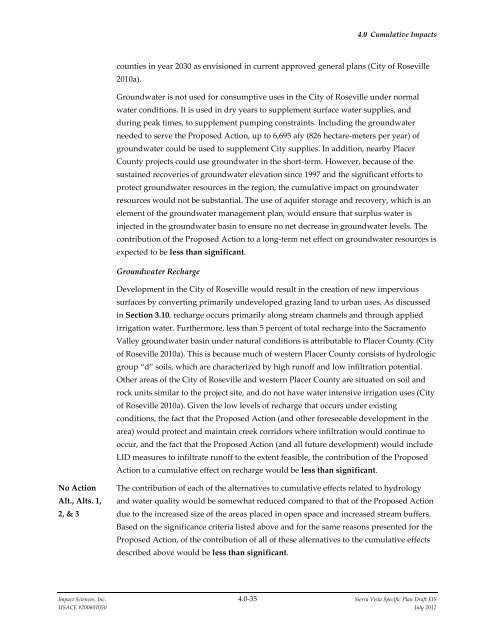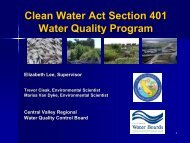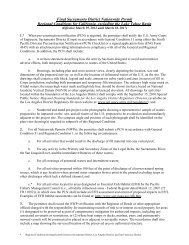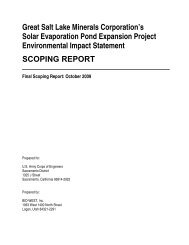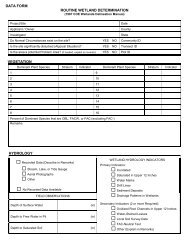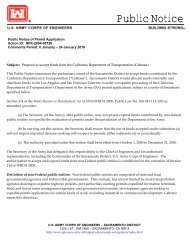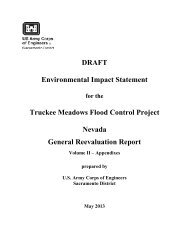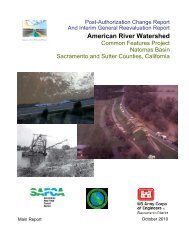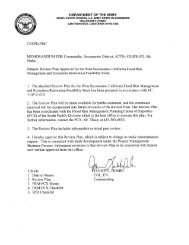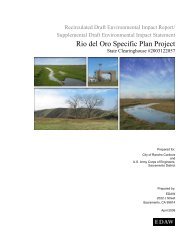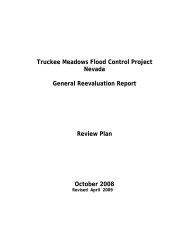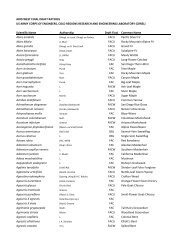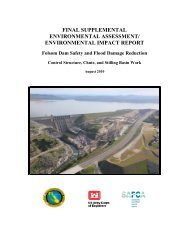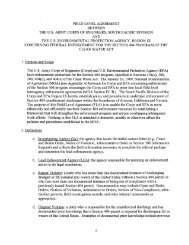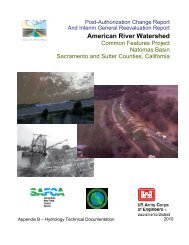4.0 CUMULATIVE IMPACTS - Sacramento District - U.S. Army
4.0 CUMULATIVE IMPACTS - Sacramento District - U.S. Army
4.0 CUMULATIVE IMPACTS - Sacramento District - U.S. Army
You also want an ePaper? Increase the reach of your titles
YUMPU automatically turns print PDFs into web optimized ePapers that Google loves.
<strong>4.0</strong> Cumulative Impacts<br />
counties in year 2030 as envisioned in current approved general plans (City of Roseville<br />
2010a).<br />
Groundwater is not used for consumptive uses in the City of Roseville under normal<br />
water conditions. It is used in dry years to supplement surface water supplies, and<br />
during peak times, to supplement pumping constraints. Including the groundwater<br />
needed to serve the Proposed Action, up to 6,695 afy (826 hectare-meters per year) of<br />
groundwater could be used to supplement City supplies. In addition, nearby Placer<br />
County projects could use groundwater in the short-term. However, because of the<br />
sustained recoveries of groundwater elevation since 1997 and the significant efforts to<br />
protect groundwater resources in the region, the cumulative impact on groundwater<br />
resources would not be substantial. The use of aquifer storage and recovery, which is an<br />
element of the groundwater management plan, would ensure that surplus water is<br />
injected in the groundwater basin to ensure no net decrease in groundwater levels. The<br />
contribution of the Proposed Action to a long-term net effect on groundwater resources is<br />
expected to be less than significant.<br />
Groundwater Recharge<br />
Development in the City of Roseville would result in the creation of new impervious<br />
surfaces by converting primarily undeveloped grazing land to urban uses. As discussed<br />
in Section 3.10, recharge occurs primarily along stream channels and through applied<br />
irrigation water. Furthermore, less than 5 percent of total recharge into the <strong>Sacramento</strong><br />
Valley groundwater basin under natural conditions is attributable to Placer County (City<br />
of Roseville 2010a). This is because much of western Placer County consists of hydrologic<br />
group “d” soils, which are characterized by high runoff and low infiltration potential.<br />
Other areas of the City of Roseville and western Placer County are situated on soil and<br />
rock units similar to the project site, and do not have water intensive irrigation uses (City<br />
of Roseville 2010a). Given the low levels of recharge that occurs under existing<br />
conditions, the fact that the Proposed Action (and other foreseeable development in the<br />
area) would protect and maintain creek corridors where infiltration would continue to<br />
occur, and the fact that the Proposed Action (and all future development) would include<br />
LID measures to infiltrate runoff to the extent feasible, the contribution of the Proposed<br />
Action to a cumulative effect on recharge would be less than significant.<br />
No Action<br />
Alt., Alts. 1,<br />
2, & 3<br />
The contribution of each of the alternatives to cumulative effects related to hydrology<br />
and water quality would be somewhat reduced compared to that of the Proposed Action<br />
due to the increased size of the areas placed in open space and increased stream buffers.<br />
Based on the significance criteria listed above and for the same reasons presented for the<br />
Proposed Action, of the contribution of all of these alternatives to the cumulative effects<br />
described above would be less than significant.<br />
Impact Sciences, Inc. <strong>4.0</strong>-35 Sierra Vista Specific Plan Draft EIS<br />
USACE #200601050 July 2012


